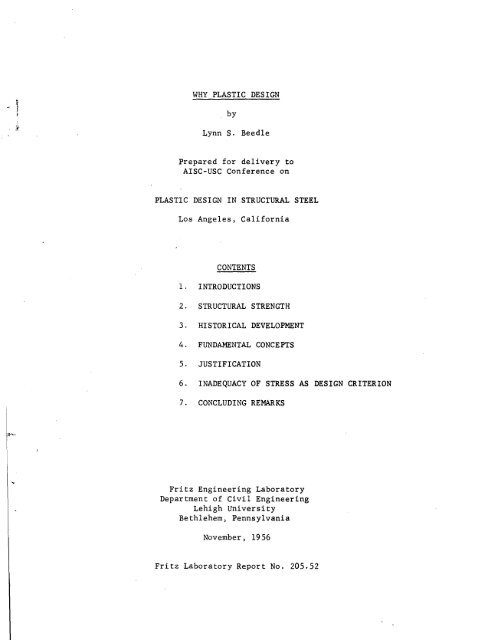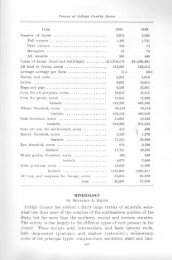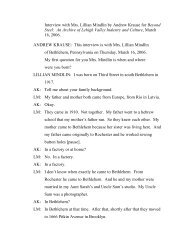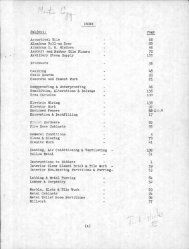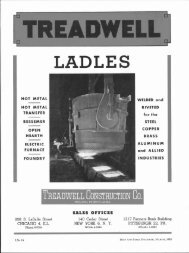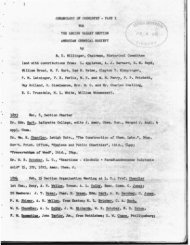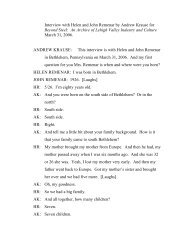WHY PLASTIC DESIGN by Lynn S. Beedle ... - Lehigh University
WHY PLASTIC DESIGN by Lynn S. Beedle ... - Lehigh University
WHY PLASTIC DESIGN by Lynn S. Beedle ... - Lehigh University
Create successful ePaper yourself
Turn your PDF publications into a flip-book with our unique Google optimized e-Paper software.
<strong>WHY</strong> <strong>PLASTIC</strong> <strong>DESIGN</strong><br />
<strong>by</strong><br />
<strong>Lynn</strong> S. <strong>Beedle</strong><br />
Prepared for delivery to<br />
AISC-USC Conference on<br />
<strong>PLASTIC</strong> <strong>DESIGN</strong> IN STRUCTURAL STEEL<br />
Los Angeles, California<br />
CONTENTS<br />
1. INTRODUCTIONS<br />
2. STRUCTURAL STRENGTH<br />
3. HISTORICAL DEVELOPMENT<br />
4. FUNDAMENTAL CONCEPTS<br />
5. JUSTIFICATION<br />
6. INADEQUACY OF STRESS AS <strong>DESIGN</strong> CRITERION<br />
7. CONCLUDING REMARKS<br />
Fritz Engineering Laboratory<br />
Department of Civil Engineering<br />
<strong>Lehigh</strong> <strong>University</strong><br />
Bethlehem, Pennsylvania<br />
November, 1956<br />
Fritz Laboratory Report No. 205.52
205.52 -2<br />
It .is our objective in this conference to present to you the available<br />
methods of plastic analysis, the design procedures that have been worked out<br />
using these methods, the experimental verification of these procedures <strong>by</strong> actual<br />
test results, and .to cover in the time that permits the secondary design consid<br />
erations that so often are a stumbling block to any new design technique. In<br />
.short, we hope to stimulate your further study of the topic. -If we do not suc<br />
ceed in demonstrating the simplicity of the plastic method, please remember that<br />
you didn't master all you know about present design methods in a few one-hour<br />
lectures.<br />
It is the purpose of this particular talk to describe the fundamental<br />
concepts involved in plastic design, to justify its application to structural<br />
steel frames, and to demonstrate that some ·of the concepts are actually a part<br />
of our present design procedures.<br />
To some of you these concepts may be new. Others of you have had<br />
some experience in solving problems. It won't hurt any of us, however,to have<br />
definitions clearly in mind and these are included in an appendix.
205.52<br />
as follows:<br />
The three essential features to this simple plastic analysis are<br />
1. each portion of the structure (each bar) reached a plastic yield<br />
condition<br />
2. the equilibrium conditiQnwas satisfied at ultimate load and<br />
3. there was unrestricted plastic flow at the ultimate load<br />
These same features are all that are required to complete the plastic analysis<br />
of an indeterminate beam or frame, and in fact, this simple example illustrates<br />
all of the essential features of a plastic analysis.<br />
3. Plastic Bending<br />
.Let us now trace the stages of yield stress penetration in a rectang-<br />
u1ar beam subjected to a progressive increase in bending moment. At the top of<br />
Figure 7, is replotted the stress-strain relationship•. We retain the assumption<br />
that bending strains are proportional to the distance from the neutral axis.<br />
At Stage 1, as shown in the next line of Figure 7 the strains have<br />
reached the yield strain. When more moment is applied (say to Stage 2), the<br />
extreme fiber strains are twice the elastic limit value. The situation is sim-<br />
ilar for Stage 3 (€max.. ,= 4€y). Finally at Stage 4 the extreme fiber has strain<br />
. ed to Est.<br />
What are the stress distributions that correspond to these strain<br />
diagrams? These are shown in the next line of Figure 7..As long as the strain<br />
is greater than the yield value, notice from the stress-strain curve that the<br />
stress remains at cry. The stress distributions, therefore follow directly from<br />
the assumed strain distributions.<br />
As a limit we obtain the "stress b1ock"-- a rectangular pattern.which<br />
is very close to the stress distribution at-Stage 4.<br />
-11
205.52 -16<br />
4. The maximum load .will be reached when a sufficient number<br />
of plastic hinges have formed to create a mechanism.<br />
6. Introduction to Methods of Analysis<br />
.Onthe basis of the principles we have just discussed perhaps you<br />
have already visualized how to compute the ultimate load: . Simply sketch a<br />
moment diagram such that plastic hinges are formed at a sufficient number of<br />
section to allow mechanism motion. Thus in Figure 12, the bending moment<br />
diagram for the uniformly-loaded, fixed-ended beam would be drawn such that.M p<br />
was reached .at the two ends and .thecenter. In this way a mechanism is formed•<br />
.Byequilibrium,<br />
WuL<br />
8'= 2M P<br />
...., 16Mp<br />
L<br />
How does this compare with the load at first yield7At the elastic<br />
limit (see dotted moment-diagram in Figure 12) we .know from.aconsiderationof<br />
continuity that the center moment is one-half the end moment. Thus,<br />
WL<br />
+= My +My =3 My<br />
2 2<br />
W Y<br />
Therefore the reserve strength due to redistribution of moment is<br />
16 Mp/t. =<br />
12 My/t<br />
4 M p<br />
3 My<br />
Considering the average shape factor of.WF beams, the total reserve strength<br />
=j (1.14)<br />
= 1.52<br />
For this particular problem, then, the ultimate load was 52% greater than the<br />
load at first yield, representing a considerable margin that is disregarded in
205.52<br />
conventional design.<br />
There are other methods for analyzing a structure for its ultimate<br />
load, in particular the ''Mechanism Method" (to bedesc.ri.bed later), which starts<br />
out with an assumed mechanism instead of an assumed moment diagram. But in<br />
every method, there are always these two important features: (1) the formatlon<br />
of plastic hinges and (2) the development of a mechanism.<br />
=17


